OOPS! You forgot to upload swfobject.js ! You must upload this file for your form to work.
G.Skill Trident X set a new record of memory frequency
![]()
|
xtreview is your : Video card - cpu - memory - Hard drive - power supply unit source |
|
|||
|
|
||||
 Recommended : Free unlimited image hosting with image editor
Recommended : Free unlimited image hosting with image editor
|
POSTER: computer news || G.SKILL TRIDENT X SET A NEW RECORD OF MEMORY FREQUENCY |
DATE:2012-04-24 |
|
|
Yesterday, Intel introduced Ivy Bridge processors, which were the first products produced on 22 nm technology. There were no significant changes in compraison with the past generation architecture (Sandy Bridge) . Nevertheless, overclockers hoped for more impressive overclocking potential, which will compensate for the slight difference in performance in terms MHz.  Shortly before the official presentation of Ivy Bridge, appeared a disturbing message that Intel not only returned to their previous TDP level, which is characteristic for the 32-nm products Sandy Bridge, but has difficulty with 22 nm technology. Journalists paid much attention to overclocking potential, based on what was produced the first overclocking statistics of Core i7-3770K. 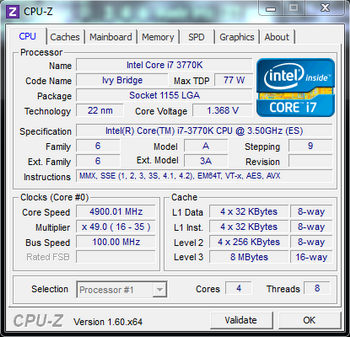 The most typical result was 4.6-4.7 GHz with a small increase in voltage. An effective cooling system (preferably liquid) allows to overclock processors at frequencies up to 5.0 GHz, and some good models are able to work a 5.5 GHz with air cooling. However, for everyday use are optimal 4.4-4.7 GHz (air) or 5 GHz (water). AnandTech conducted detailed studies of energy dependence and CPU core voltage temperature. Temperature measurements were made using the tool PovRay, power consumption was measured by OCCT. 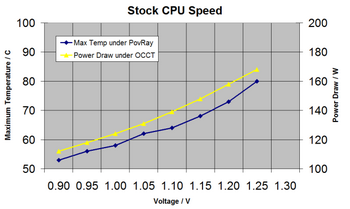 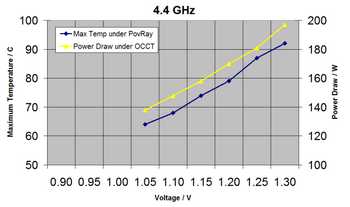 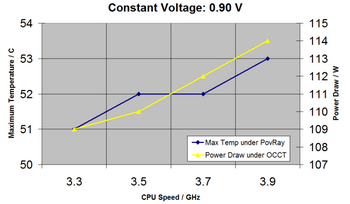 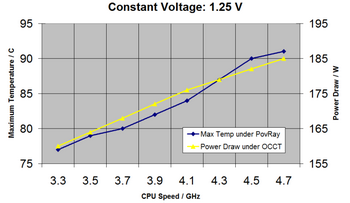 The dependence of the maximum achievable frequency on voltage:  It should be noted that Ivy Bridge processors does not like to increase the voltage and power settings, it heated to a temperature above 90 � C, which must be considered when overclocking. Related Products : | ||
|
|
||
|
xtreview is your : Video card - cpu - memory - Hard drive - power supply unit source |
|
|
|
|
||
|
Xtreview Support  N-Post:xxxx Xtreview Support        |
G.SKILL TRIDENT X SET A NEW RECORD OF MEMORY FREQUENCY |
| Please Feel Free to write any Comment; Thanks  |
G.Skill presented sets of memory modules Trident Z RGB DDR4 up to 128 GB (2017-04-09)
MSI has introduced a compact 3 Trident Arctic gaming system (2017-03-29)
G.Skill has released new memory kits Trident Z DDR4 low-latency (2016-05-17)
G.Skill Trident Z memory Modules is now available in many different color schemes (2016-05-09)
G.Skill introduced Trident Z series DDR4-4133 memory (2015-11-21)
Overclockers from TeamAU team set a world record by overclocking memory G.Skill TridentX DDR3-3000 frequency to 2202 MHz (2013-08-12)
G.Skill TridentX DDR3-3000 (2013-06-02)
gskill TridentX 32GB DDR3 (2013-02-06)
G.Skill Trident X F3-2800C11Q-32GTXD (2013-02-05)
G.Skill Trident X set a new record of memory frequency (2012-04-24)
DDR3 G.Skill Trident X (2012-04-19)
GSkill F3 16000CL9 trident (2009-04-08)
![]()
To figure out your best laptops .Welcome to XTreview.com. Here u can find a complete computer hardware guide and laptop rating .More than 500 reviews of modern PC to understand the basic architecture


7600gt review
7600gt is the middle card range.
We already benchmarked this video card and found that ...

 geforce 8800gtx and 8800gts
geforce 8800gtx and 8800gts  Xtreview software download Section
Xtreview software download Section  AMD TURION 64 X2 REVIEW
AMD TURION 64 X2 REVIEW  INTEL PENTIUM D 920 , INTEL PENTIUM D 930
INTEL PENTIUM D 920 , INTEL PENTIUM D 930  6800XT REVIEW
6800XT REVIEW  computer hardware REVIEW
computer hardware REVIEW  INTEL CONROE CORE DUO 2 REVIEW VS AMD AM2
INTEL CONROE CORE DUO 2 REVIEW VS AMD AM2  INTEL PENTIUM D 805 INTEL D805
INTEL PENTIUM D 805 INTEL D805  Free desktop wallpaper
Free desktop wallpaper  online fighting game
online fighting game  Xtreview price comparison center
Xtreview price comparison center Lastest 15 Reviews


Rss Feeds
Last News
- The new version of GPU-Z finally kills the belief in the miracle of Vega transformation
- The motherboard manufacturer confirms the characteristics of the processors Coffee Lake
- We are looking for copper coolers on NVIDIA Volta computing accelerators
- Unofficially about Intels plans to release 300-series chipset
- The Japanese representation of AMD offered monetary compensation to the first buyers of Ryzen Threadripper
- This year will not be released more than 45 million motherboards
- TSMC denies the presentation of charges from the antimonopoly authorities
- Radeon RX Vega 64 at frequencies 1802-1000 MHz updated the record GPUPI 1B
- AMD itself would like to believe that mobile processors Ryzen have already been released
- AMD Vega 20 will find application in accelerating computations
- Pre-orders for new iPhone start next week
- Radeon RX Vega 57, 58 and 59: the wonders of transformation
- ASML starts commercial delivery of EUV-scanners
- The older Skylake processors with a free multiplier are removed from production
- Meizu will release Android-smartphone based on Helio P40
- AMD Bristol Ridge processors are also available in American retail
- The fate of Toshiba Memory can be solved to the next environment
- duo GeForce GTX 1080 Ti in GPUPI 1B at frequencies of 2480-10320 MHz
- New Kentsfield overclocking record up to 5204 MHz
- Lenovo released Android-smartphone K8

HALO 3 HALO 3 - Final Fight!

PREY Prey is something you don t often see anymore: a totally unigue shooter experience.

computer news computer parts review Old Forum Downloads New Forum Login Join Articles terms Hardware blog Sitemap Get Freebies


